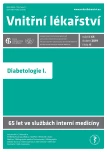Diabetes in pregnancy: current ways of treatment
Authors:
Dagmar Bartášková
Authors‘ workplace:
Interní klinika 2. LF UK a FN Motol, Praha
Published in:
Vnitř Lék 2019; 65(4): 256-263
Category:
Overview
It is well known, that number of diabetics pregnancies is raising. It is due to growing amount of women with type 1 and type 2 diabetes, which can easily reach the right age for pregnancy. It allows new ways of diabetes treatment, new technologies and in general better health state of this women. Displacement the pregnancy to later age, leads to gestational diabetes increasing. Especially women with pregestational diabetes are in higher risk of perinatal and diabetic complications. More than half of all pregnancies are not planned and so that often not well controlled or used inappropriate medication. Preterm deliveries, acute sectiones cesarea, eclampsia, preeclampsia or higher risk of late diabetics complications are in consequencies. The article brings the current point of view to treatment diabetic pregnancies with respect to prevent all types of complications.
Keywords:
continuous glucose monitoring in pregnancy – diabetes mellitus type 2 – diabetes therapy in pregnancy – gestational diabetes mellitus – gravidita – insulinotherapy pregnancy – selfmonitoring in pregnancy
Sources
-
Bartoš V, Pelikánová T. Praktická diabetologie. 4. ed. Maxdorf: Praha 2010. ISBN 978–80–7345–216–2.
-
Diabetes and Pregnancy Evidence Based Update and Guidelines, European Association of Perinatal Medicine, Prague, 2006, Working Group on Diabetes and Pregnancy.
-
Reece EA, Coustan DR, Gabbe SG (eds). Diabetes Mellitus in Women: Adolescence through Pregnancy and Menopause. 3rd ed. Lippincott Williams and Wilkins: 2004. ISBN-13: 978–0781738613
-
Štechová K et al. Dítě diabetické matky. Geum: Semily 2014. ISBN 978–80–87969–06–9.
-
Temple RC, Aldridge VJ, Murphy HR. Pregnancy care and pregnancy outcome in women with type 1 diabetes. Diabetes Care 2006; 29(8): 1744–1749. Dostupné z DOI: <http://dx.doi.org/10.2337/dc05–2265>.
-
Van Assche FA. Diabetes and Pregnancy. European Practice in Gynaecology and Obstetrics 2004; 10: 56–92.
-
Nielesen LR, Pedresen-Bjergaard U, Thorsteinsson B et al. Hypoglycaemia in pregnant women with type 1 diabetes: predictors and role of metabolic control. Diabetes Care 2008; 31(1): 9–14. Dostupné z DOI: <http://dx.doi.org/10.2337/dc07–1066>.
-
Smoak IW, Sadler TW. Embryopathic effects of short-term exposure to hypoglycemia in mouse embryos in vitro. Am J Obstet Gynecol 1990; 163(2): 619–624.
-
James ML, Brendan T. Insulin therapy for the treatment of type 1 diabetes during pregnancy. J Matern Fetal Neonatal Med 2014; 27(12): 1270–1275.
-
Heise et al. ADA 76th Scientific Sessions 2016: Pooled analysis of NN1218 trials 3887, 3888, 3889, 3891, 3921, 3978. GIR.
-
Bertini AM, Silva JC, Taborda W et al. Pperinatal outcomes and the use of oral hypoglycemic agents. J Perinat Med 2005; 33(6): 519–523. Dostupné z DOI: <http://dx.doi.org/10.1515/JPM.2005.092>.
-
Brown FM, Wychoff J, Rowan JA et al. Metformin in pregnancy: its time has not yet come. Diab Care 2006; 29(2): 485–486.
-
Homko CJ, Sivan E,Reece AE. Is there a role for oral antihyperglycemics in gestational diabetes and type 2 diabetes during pregnancy? Treat Endocrinol 2004; 3(3): 133–139.
-
Huges RC, Rowan JA. Pregnancy in women Type 2 diabetes: who takes metformin and what is the outcome? Diabet Med 2006; 23(3): 318–322. Dostupné z DOI: <http://dx.doi.org/10.1111/j.1464–5491.2006.01750.x>.
-
Ramos GA, Jacobson GF, Kirby RS et al. Comparison of glyburide and insulin for the management of gestational diabetics with markedly elevated oral glucose challenge test and fasting hyperglycemia. J Perinatol 2007; 27(5): 262–267. Dostupné z DOI: <http://dx.doi.org/10.1038/sj.jp.7211683>.
-
16 Hewapathirana NM, O’Sullivan E, Murphy HR. Role of Continuous Glucose Monitoring in the management of Diabetic Pregnancy. Curr Diab Rep 2013; 13(1): 34–42. Dostupné z DOI: http://dx.doi.org/10.1007/s11892–012–0337–9>.
-
Pickup J, Keen H. Continuous subcutaneous insulin infusion at 25 years: evidence base for the expanding use of insulin pump therapy in type 1 diabetes. Diabetes Care 2002; 25(3): 593–598.
-
Štechová K et al. Technologie v diabetologii. Maxdorf: Praha 2016: 37–52. ISBN 978–80–7345–479–1.
-
Stenninger E, Lindqvist A, Aman J et al. Continuous subcutaneous glucose monitoring system in diabetic mothers during labour and postnatal glucose adaptation of their infants. Diabet Med 2008; 25(4): 450–454. Dostupné z DOI: <http://dx.doi.org/10.1111/j.1464–5491.2008.02416.x>.
-
Yeh HC, Brown TT, Maruthur N et al. Comparative effectiveness and safety of methods of insulin delivery and glucose monitoring for diabetes mellitus: a systematic review and meta- analysis. Ann Intern Med 2012; 157(5): 336–347. Dostupné z DOI: <http://dx.doi.org/10.7326/0003–4819–157–5-201209040–00508>.
-
Yogev Y, Ben-Haroush A, Chen R et al. Continuous Glucose Monitoring for treatment adjustment in diabetic pregnancies, a pilot study. Diabet Med 2003; 20(7): 558–562
-
Doporučení České diabetologické společnosti pro léčbu diabetu metforminem v těhotenství. Dostupné z WWW: <www.diab.cz>.
-
American Diabetes Association. Management of Diabetes in Pregnancy: Standards of Medical Care in Diabetes – 2019. Diabetes Care 2019; 42(Suppl 1): S165–S172. Dostupné z DOI: <https://doi.org/10.2337/dc19-S014>.
Labels
Diabetology Endocrinology Internal medicineArticle was published in
Internal Medicine

2019 Issue 4
Most read in this issue
- Primary and secondary insulin resistance
- Current view of treatment of hypoglycemia
- Diabetes mellitus 1. typu: etiologie a epidemiologie
- Driver medical fitness and diabetes mellitus: legislative changes in 2018 and a summary of health aspects
